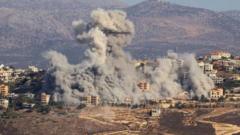There have been many moments of extreme danger over the past year. This is the worst. In the past seven days, Hezbollah leader Hassan Nasrallah has been assassinated, Israel has launched a ground invasion of Lebanon, and Iran has fired nearly 200 ballistic missiles at targets across Israel.
Western and regional powers - led by the US - have pushed for de-escalation. The UN Security Council called for an "immediate end" to hostilities and the G7, which includes the US, UK and Germany, has called for “restraint”. But so far those efforts have failed - and the Middle East stands closer than ever to all-out war.
Here’s how the last week played out. As the sun set over Beirut on 27 September, the south of the city was hit by a series of huge explosions. Several apartment buildings had been struck, leaving a huge crater in the ground.
Plumes of dust and debris filled the skyline, visible from across the Lebanese capital. The strike, aimed at an underground bunker, killed Hezbollah leader Hassan Nasrallah . Seen as a prize-target, Nasrallah had not been seen in public for years for fear of being assassinated by Israel.
His death capped a week of ramped-up Israeli strikes targeting Hezbollah that had left more than 500 people dead. The week before that, a series of walkie-talkie and pager explosions targeting the group left at least 32 dead and over 3000 injured. Nasrallah’s death wiped all hopes of a de-escalation, which just hours earlier had seemed possible.
A US proposal .


















